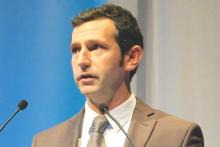VIENNA – Immunotherapy with atezolizumab was active in patients with advanced lung cancer expressing PD-L1, regardless of the line of treatment in the BIRCH trial.
Additional follow-up in the sister POPLAR trial allowed atezolizumab to claim superior overall survival over docetaxel as second-line therapy in unselected lung cancer patients.
Atezolizumab is the second checkpoint inhibitor after nivolumab (Opdivo) to show superior efficacy to standard chemotherapy.
In both phase II trials, efficacy with the cell programmed death ligand 1 (PD-L1) inhibitor correlated with PD-L1 expression status.
“Higher PD-L1 expression correlates with higher responses” and may allow for identification of NSCLC patients who are likely to benefit from atezolizumab therapy, BIRCH study author Dr. Benjamin Besse of Institut Gustave Roussy in Villejuif, France, said at the European Cancer Congress 2015.
More than 30,000 patients were screened in 2014 for the single-arm trial, of which 34% were PD-L1 positive. In all, 667 patients with PD-L1-positive, locally advanced or metastatic non–small cell lung cancer (NSCLC) received atezolizumab 1,200 mg IV every 3 weeks as first-line or subsequent therapy. The Ventana SP142 immunohistochemistry assay was used to measure PD-L1 expression on both tumor cells (TC) and immune cells (IC). Roughly half of the patients (46%) had very high levels of PD-L1 expression (TC3 or IC3 status).
Patients were stratified into three cohorts: Cohort 1 had no prior therapy, cohort 2 had received one prior platinum-based chemotherapy, and cohort 3 had undergone at least two chemotherapies, including one platinum-based regimen.
The primary endpoint of objective response rate (ORR) by independent review was 19%, 17%, and 17% for the three cohorts, and increased to 26%, 24%, and 27%, respectively, when the analysis was restricted to patients with TC3 or IC3 status, Dr. Besse reported.
The majority of responses are ongoing (greater than 61% in TC3 or IC3).
Six-month overall survival rates were 82% in cohort 1, 76% in cohort 2, and 71% in cohort 3, and 79%, 80%, and 75%, respectively, in patients with TC3 or IC3 status.
The overall survival data are not yet mature after a median follow-up of 8.8 months, but the 6-month survival rates are consistent with results in POPLAR for the patients with two or three prior lines of therapy, he said.
Treatment-related grade 3/4 events occurred in 11% of 659 evaluable patients, with 5% of patients stopping atezolizumab due to an adverse event.
The safety profile is consistent with previous atezolizumab monotherapy trials, with no unexpected signals or differences in toxicity across cohorts, Dr. Besse said.
POPLAR took a different tack, evaluating the same dose of atezolizumab vs. docetaxel 75 mg/m2 IV every 3 weeks until disease progression, but in all-comers with metastatic or locally advanced NSCLC (second or third-line) who had progressed on a prior platinum therapy. The 287 patients were stratified by PD-L1 IC expression, histology, and number of prior chemotherapy regimens. In all, 16% of patients were TC3 or IC3.
The survival signal with atezolizumab was less impressive when seen at this year’s American Society of Clinical Oncology (ASCO) meeting, but with three additional months’ follow-up it now significantly favored immunotherapy over docetaxel in an intent-to-treat analysis (median 12.6 months vs. 9.7 months; hazard ratio, 0.73; P = .040).
“We have a minimum follow-up of 13 months, which means this part of the curve is less stable at the present time, but nonetheless the picture emerges that there will be ongoing separation of the curve,” study author Dr. Johan Vansteenkiste of University Hospitals KU Leuven, Belgium, said during the same immunotherapy session.
When the analysis was stratified by PD-L1 expression, the hazard ratios were 0.49 for the TC3 or IC3 patients with very high PD-L1 expression, 0.54 for TC2/3 or IC2/3 patients, 0.59 for TC1/2/3 or IC1/2/3 patients, and 1.04 for those without any PD-L1 expression.
“So there is a kind of a gradient of increasing benefit according to increased expression of PD-L1,” he said, adding that the same phenomenon was present for progression-free survival, with perhaps an even steeper gradient of increasing benefit according to intensity of staining.
The overall survival benefit was also observed in patients with squamous (HR, 0.80) and nonsquamous (HR, 0.69) histology.
The overall response rate was 15% for atezolizumab and docetaxel in the ITT analysis. Overall response differed in the subgroup with very high PD-L1 expression at 38% vs. 13%, respectively, but not in the other PD-L1 subgroups, Dr. Vansteenkiste said.
The median duration of response was 14.3 months with atezolizumab and 7.2 months with docetaxel (HR, 0.41; P = .033), with most responses ongoing, he said.



